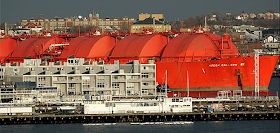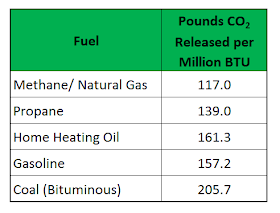One of the major sources of energy in New Hampshire is natural
gas. Natural gas has also been a major disruptive force in the energy markets
throughout the US. Just five years ago, we were importing significant
quantities of natural gas into the US and foreign deliveries of liquefied
natural gas, such as that shown below, to storage depots located in Boston
harbor were the order of the day.
In 2008 fracking technology kicked into high gear and we
were able to release the vast resources of previously inaccessible natural gas
and oil located in shale deposits in Texas, Pennsylvania, North Dakota, and
other places.
Natural gas is typically transported by major interstate pipelines
that run across the US. As I noted in my
previous post, these steel gas pipelines are 20 to 42 inches in diameter
and are buried underground along 100 ft rights of way. Compressor stations along
the pipelines maintain the gas pressures, which can range from 200 to 1500 pounds
per square inch. The natural gas is then directed to distribution points where
it passes through a gate station. Here it becomes the responsibility of the
local distribution company which then drops the pressure, adds the odorant that
gives natural gas its distinct smell, and directs the gas through lower
pressure and smaller 2 to 8 inch mainlines to homes and business. Service lines
branching off the distribution mainline bring the gas directly into homes or
businesses.
Natural gas can also be compressed and transported as
compressed natural gas, CNG, or even liquefied at very high pressures to
form liquefied natural gas, LNG, which can be transported by rail, truck, or
ship (as shown in the picture above). In fact, CNG and LNG are interesting and
growing options to get natural gas to areas where there are no natural gas
pipelines (but that will be a topic for a future blog). In this post, we focus
on natural gas transported in pipelines.
As shown in the figure below, the US has an impressive
network of natural gas pipelines snaking their way across the country,
especially across the central corridor from the Great Lakes down through Texas
and the Gulf Coast region. The gas pipeline network is particularly dense in
the areas where the natural gas is found, such as Texas, Oklahoma, Louisiana,
and Pennsylvania.
Source: EIA
The figure above and the accompanying figure below, which shows more detail for New England,
indicate that the natural gas network is rather more spread out in the
Northeast. Massachusetts and Connecticut are reasonably well serviced but this
pipeline network somewhat peters out for the northern New England states. When
it comes to natural gas pipelines, New Hampshire and Vermont are literally at “the
end of the line”.*
In NH there are only four natural gas pipelines. The most
important for NH residents is the Tennessee Gas Pipeline (TGP) which is owned
by Kinder Morgan and which brings gas from Texas, Louisiana, and the Gulf of
Mexico into New England. This pipeline crosses New York state and the length of
Massachusetts and distributes gas across a large part of MA. This pipeline has several
tributaries, one of which branches off near Lowell in Massachusetts and heads
north into NH along the communities near the Merrimack River and reaching as
far as the Lakes region.
In the northern part of the state, the Portland Natural Gas Transmission System
(PNGTS) pipeline (shown in light blue in the map above) brings in gas from
Canada from the Trans-Quebec and Maritimes pipeline systems. This pipeline
drops down from Canada along the VT/NH border and then crosses the northern
part of the state into Maine where it heads for the seacoast to join up with
the Maritimes and Northeast (M&N) pipeline. The PNGTS pipeline, owned by two
Canadian gas companies, TransCanada and
Gaz Metro, is not a distribution pipeline to deliver gas to NH. Instead it is a
transmission pipeline focused on bringing Canadian natural gas to some major
paper mill operations in Maine and natural gas-fired generation operations in
New England. After this connects with the M&N pipeline in Westbrook, ME, it
drops down through the Maine and NH seacoast area, dropping off natural gas in
the Portsmouth area on its way to Dracut and Haverhill, MA, to bring Canadian natural
gas to the area north of Boston. The section of the pipeline from Westbrook, ME,
to Dracut, MA, is a joint venture between PNGTS and M&N.
Source: PNGTS
In NH, the PNGTS pipeline has three metering stations, one
in Pittsburg, another in Groveton (the now defunct site of the Groveton and
Washau Paper Mills), and an important one in Berlin. At this station, natural
gas is tapped off the PNHTS pipeline and distributed in the local Berlin area by
Liberty Utilities, which accounts for a lone island of natural gas supply in
the northern part of the state. The Gorham paper mill also accesses natural gas
from this pipeline and it is the cheap fuel from this pipeline that is large
part of why this paper mill is still a
viable operation. However, increases in natural gas prices this past winter
caused the paper mill
to curtail operations and lay off workers. The metering stations represent potential
distribution points for natural gas and plans
are afoot to use the Groveton and Gorham sites as a distribution point for
LNG.
The third pipeline that impacts New Hampshire is the 730-mile
long M&N pipeline that brings in natural gas from New Brunswick, the Sable,
and Deep Panuke natural gas deposits offshore of Nova Scotia as well as from
the LNG storage and re-gasification facility in St. John, New Brunswick. This
pipeline is jointly owned by Spectra Energy, Emera, and Exxon Mobil. It
connects with the PNGTS in Westford, Maine and, as mentioned above, it then
shares the pipeline with PNGTS to head south along the Maine and New Hampshire
seacoast on its journey to Dracut. It also branches off and delivers gas to
Methuen and Beverley, MA. Its original function was to bring Canadian natural
gas from the Maritimes to Atlantic Canada and New England, however, with gas
production from Maritimes offshore deposits declining and increased natural gas
consumption in the Maritimes states, there could in the future be a shortage of
natural gas in the Canadian Atlantic states. In a remarkable reversal, consideration
is now been given to reversing the
flow of natural gas along parts of this pipeline to bring gas from the Pennsylvanian
natural gas deposits up through New England and then sending it north to Maine and perhaps even into Atlantic Canada.
The fourth pipeline is the Granite State Gas Transmission
(GSGT) pipeline that runs from Haverhill, MA, up to Portland, ME. This pipeline
is owned by Unitil and, for most of its journey, runs in parallel with the
PNGTS and M&N shared pipeline, as can be seen from the map below. This
pipeline picks up gas from the hubs in the Haverhill area (from either the
PNGTS, M&N, or the TGP pipelines)
and then sends it north up the seacoast to Portland, Maine, where it supplies
the Unitil distribution network along this area.
Source: GSTS
With knowledge of these four pipelines, it is now
straightforward to understand which communities in NH have natural gas, as
shown on the map below. As noted, we have the lone northern island of natural
gas supply in Berlin where the gas is delivered by PNGTS pipeline. We also have
the seacoast communities in dark blue, where the gas is supplied by the GSGT
pipeline, and then we have the communities along the Merrimack corridor that
tap into the tributary of the TGP pipeline. [There is a single small propane distribution network in Keene which is shown in grey.]
Source: NHPUC
The seacoast area is the service area of Unitil and the
Merrimack corridor, and the lone dropoff point in Berlin is serviced by Liberty
Utilities. These are the only two local distribution companies in New Hampshire that deliver natural gas to
residential, commercial, and industrial customers through their distribution
network.
My next post will take a closer look at these local natural
gas distribution companies, but, in the meantime, it is important to be aware
that, even though I am looking at natural gas from a NH perspective, we need to
appreciate that natural gas consumption and supply is very much a regional
matter. All natural gas is imported into New England. It comes in from Texas, Pennsylvania,
Canada, and the Maritimes and its supply is very limited by the size and number
of pipelines. Natural gas is very much like electricity—difficult to store and
much of its use is on demand. When there is insufficient natural gas, electricity
production is compromised and the lights could go out.
So until my next post, do your part to keep the lights on by
remembering to turn off the lights when you leave the room.
Mike Mooiman
Franklin Pierce University
mooimanm@franklinpierce.edu
Click on this link to receive email notifications for Energy in New Hampshire updates
Click on this link to receive email notifications for Energy in New Hampshire updates
(End of
the Line* - A great tune from the band The Travelling Wilburys that really
lived up to its “supergroup” labeling.
Featuring George Harrison, Tom Petty, Jeff Lynne, Roy Orbison, and Bob Dylan,
the group’s two albums remind us of what happens when a
lot of musical talent and a great deal of superb songwriting come together.)













